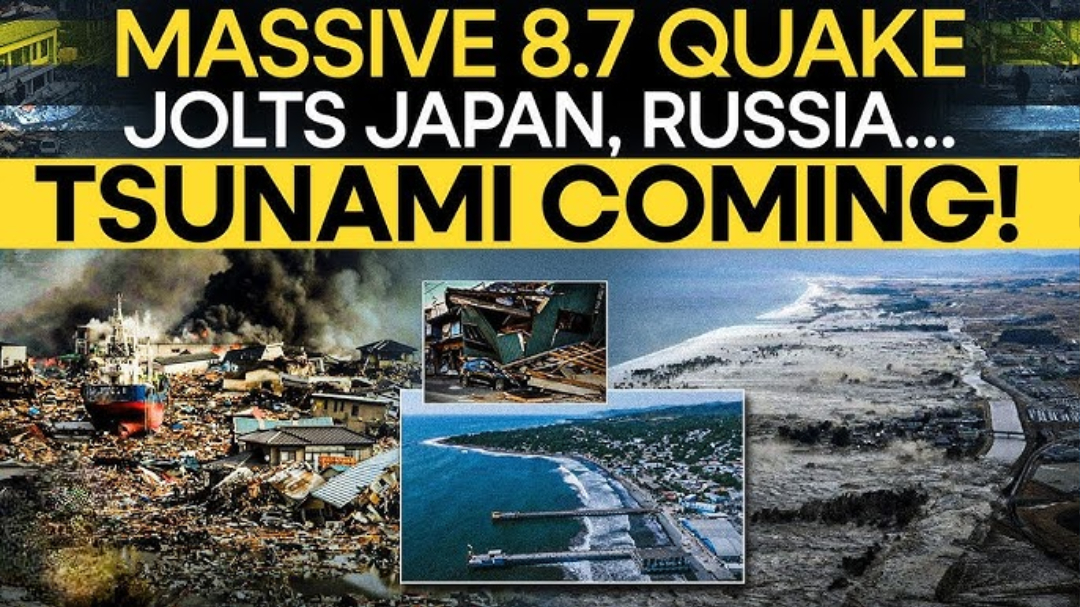
Tsunami waves hit Russia, US, Japan after 8.8-magnitude earthquake off Kamchatka Peninsula
8.8 Magnitude Kamchatka Earthquake Triggers Tsunami Warnings: Latest Updates for Japan, Alaska, and Hawaii
A powerful 8.8-magnitude earthquake just rocked the ocean floor off Russia’s remote Kamchatka Peninsula. This massive quake immediately sent shockwaves across the Pacific, triggering urgent tsunami warnings for several coastal regions. People living along the vast Pacific Rim are now on high alert.
The most immediate concern quickly shifted to Japan, Alaska, and Hawaii. Residents in these areas faced the terrifying possibility of incoming tsunami waves. Coastal communities braced for impact, unsure of what the sea would bring. Fear and anticipation gripped everyone watching the news.
This article brings you a full overview of this major seismic event. We will cover the earthquake itself, the widespread tsunami threat, and the actual wave impacts reported so far. We will also discuss the vital preparedness steps taken to keep people safe.
Understanding the Kamchatka Earthquake
Magnitude and Epicenter Details
The earthquake hit with a huge 8.8 magnitude. It struck deep beneath the waters off the Kamchatka Peninsula in Russia. This powerful tremor happened at a significant depth, meaning its energy traveled widely. It occurred where the Pacific Plate dives beneath the Okhotsk Plate, a process known as subduction. This deep movement causes some of the world’s strongest quakes.
Seismic Activity in the Region
Kamchatka sits on the notorious Pacific Ring of Fire. This horseshoe-shaped zone sees frequent and intense seismic activity. Here, many tectonic plates meet, grind, and overlap. This constant motion makes the area prone to very powerful earthquakes and volcanic eruptions. It’s why residents in this part of the world live with the constant risk of large seismic events.
Tsunami Warnings and Coastal Impacts
Initial Tsunami Warnings Issued
Right after the quake, tsunami warnings went out fast. The Pacific Tsunami Warning Center (PTWC) quickly issued alerts for Japan, Alaska, and Hawaii. People living in these coastal areas were told to seek higher ground. These warnings came out within minutes, giving vital time for initial safety steps. Officials also issued advisories for other Pacific nations, urging caution.
Observed Tsunami Waves: Japan
Tsunami waves have now been reported in Japan. Reports indicate several coastal areas saw small, but noticeable, wave heights. These waves arrived within hours of the earthquake. While initial reports did not show major damage, water levels did rise in harbors. Local officials kept a close watch for any changes, ready to act if conditions worsened.
Observed Tsunami Waves: Alaska and Hawaii
Further east, tsunami waves also reached Alaska’s coastline. Some remote areas saw modest changes in sea level. In Hawaii, waves arrived several hours later. These waves were generally small, less than a foot or two in height. Harbors saw stronger currents, which could be dangerous to boats. Thankfully, widespread damage reports were not immediate.
Preparedness and Response Efforts
Evacuation and Safety Measures
Coastal communities acted fast when the warnings came. In Japan, Alaska, and Hawaii, local authorities urged people in low-lying areas to evacuate. Many residents moved to higher ground as a safety measure. Emergency services were on standby, ready to help anyone in need. These quick actions saved lives and prevented widespread chaos.
International Cooperation and Monitoring
The Pacific Tsunami Warning Center played a key role. They monitored the tsunami’s path across the ocean. They shared vital updates with many countries. This international teamwork helps ensure that accurate and timely information reaches everyone. Global cooperation is key to dealing with such massive natural events.
Expert Analysis and Scientific Perspectives
Seismologists and tsunami experts offered their insights. They explained that an 8.8-magnitude quake is truly massive. Its depth helped to lessen the local shaking, but it sent out powerful tsunami waves. Experts continue to study the data. They want to learn more about how the ocean floor moved during this big event.
Lessons Learned and Future Preparedness
Historical Context of Kamchatka Earthquakes
The Kamchatka region has a history of powerful quakes. Past events have also created large tsunamis that traveled far. These historical quakes remind us of the constant threat in this active zone. Learning from these past events helps improve future responses. It shows why continued vigilance is so important.
Enhancing Tsunami Warning Systems
This recent event highlights the importance of fast warning systems. It shows the need for clear communication to the public. Can we make these systems even better? Experts are always looking for ways to improve how warnings are sent. They want to ensure everyone gets the message quickly and clearly.
Community Resilience and Disaster Preparedness
Living in a tsunami-prone area means staying ready. Do you know your local evacuation routes? Does your family have an emergency kit? These simple steps can make a big difference when disaster strikes. Being prepared builds stronger, more resilient communities. Your safety starts with a plan.
Conclusion
The 8.8-magnitude earthquake off Kamchatka was a major event. It triggered widespread tsunami warnings and led to observed waves in Japan, Alaska, and Hawaii. This powerful quake reminded us of Earth’s raw power.
Timely warnings and strong preparedness efforts are very important. They help reduce the harm from such natural disasters. We must stay ready and aware.
Ongoing monitoring and constant vigilance are still needed. We live in a world where nature’s forces are always at work. Being prepared is our best defense.



